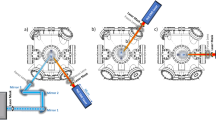Uncertainty in precursor pulse delays and shapes has been found to be an important factor in Hg1−x Cd x Te metal-organic chemical vapor deposition (MOCVD) growth using the interdiffused multilayer process (IMP). Herein, metal-organic concentration changes in the growth zone are examined using an in␣situ infrared (IR) absorption gas monitoring system, and modifications to the interdiffused multilayer process are applied for in␣situ control of stoichiometry, improved morphology, minimized process length, and consumption of precursors. Dimethylcadmium (DMCd) introduction during IMP flush stages in HgTe was used for stoichiometry control. The final stage of heterostructure formation was optimized to prevent Hg outdiffusion. As a result, vacancy concentration was reduced far below the equilibrium level at the growth conditions so the background of n-type doping was revealed. Acceptor doping with arsine (AsH3) and trisdimethylaminoarsenic (TDMAAs) was examined over a wide range of compositions, and doping levels of 5 × 1015 cm−3 to 5 × 1017 cm−3 were obtained. The presence of both arsenic dopants significantly increased the CdTe growth rate. This caused an increase of Cd mole fraction in the grown material. Doped heterostructures can be grown without any postgrowth anneal and used for mid- and long-wavelength infrared (MWIR and LWIR) devices operating at near-ambient temperatures.
Similar content being viewed by others
References
S.J.C. Irvine and J.B. Mullin, J. Cryst. Growth 55, 107 (1981)
J.B. Mullin and S.J.C. Irvine, J. Vac. Sci. Technol. 21, 178 (1982)
N.T. Gordon, R.S. Hall, C.L. Jones, C.D. Maxey, N.E. Metcalfe, R.A. Catchpole and A.M. White, J. Electron. Mater. 29, 818 (2000)
J. Piotrowski, Opto-Electron. Rev. 12, 111 (2004)
A. Piotrowski, W. Gawron, K. Klos, P. Madejczyk, M. Romanis, M. Grudzien, J. Piotrowski and A. Rogalski, Proc. SPIE 5732, 273 (2005)
T. Elliott, N.T. Gordon and A.M. White, Appl. Phys. Lett. 74, 2881 (1999)
J. Piotrowski, Opto-Electron. Rev. 12, 111 (2004)
J. Piotrowski, P. Brzozowski and K. Jóźwikowski, J. Electron. Mater. 32, 672 (2003)
S.J.C. Irvine, Narrow-Gap II-VI Compounds for Optoelectronic and Electro-magnetic Applications, ed. P. Capper (UK: Chapman & Hall, 1997), pp. 71–96
S.A. Svoronos, W.W. Woo, S.J.C. Irvine, H.O. Sankur and J. Bajaj, J. Electron. Mater. 25, 1561 (1996)
I. Mora-Sero, C. Polop, C. Ocal, M. Aguilo and V. Munoz-Sanjose, J. Cryst. Growth 257(1–2), 60 (2003)
H.R. Vydyanath, J. Vac. Sci. Technol. B9, 1716 (1991)
P. Mitra, F.C. Case and M.B. Reine, J. Electron Mater. 27, 510 (1998)
Acknowledgement
This work was supported by the Polish Ministry of Science and Information Technology.
Author information
Authors and Affiliations
Corresponding author
Additional information
Student paper; supervisors are A. Rogalski, J. Piotrowski and J. Szmidt
Rights and permissions
About this article
Cite this article
Piotrowski, A., Kłos, K. Metal-Organic Chemical Vapor Deposition of Hg1−x Cd x Te Fully Doped Heterostructures Without Postgrowth Anneal for Uncooled MWIR and LWIR Detectors. J. Electron. Mater. 36, 1052–1058 (2007). https://doi.org/10.1007/s11664-007-0171-z
Received:
Accepted:
Published:
Issue Date:
DOI: https://doi.org/10.1007/s11664-007-0171-z




